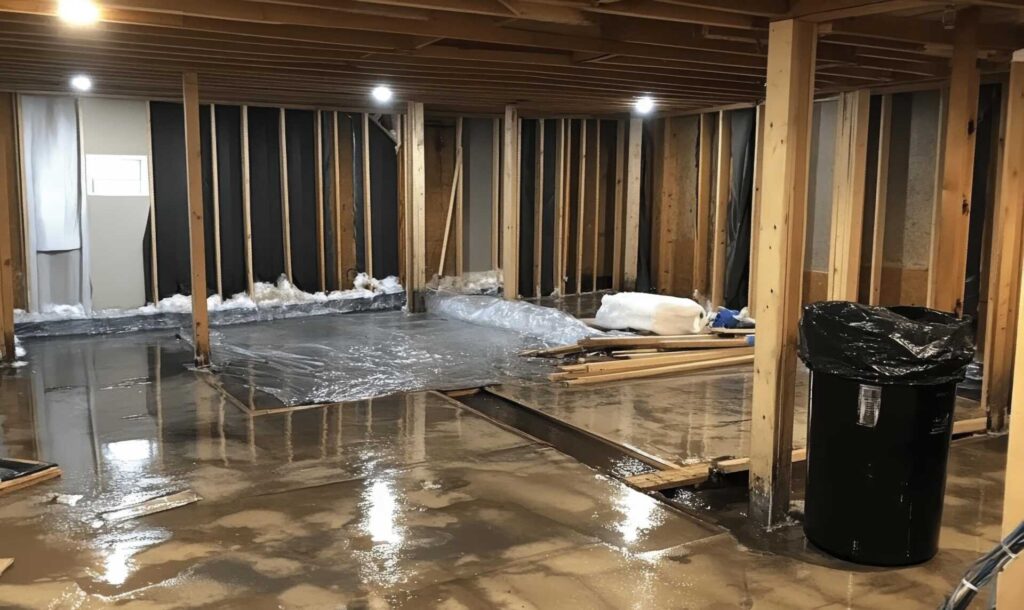
Contents
When dealing with a flooded basement, your first step is to ensure safety by turning off the electricity. Next, assess the damage and document any visible issues. Understanding the extent of the flooding is essential before you proceed with water removal. Various techniques and equipment are available for effective extraction, but knowing the right approach can make all the difference. Let’s explore the methods that will restore your space efficiently.
Key Takeaways
- Conduct a thorough damage assessment and document visible signs of flooding before starting restoration efforts.
- Use appropriate water removal techniques, such as submersible pumps for large volumes and wet/dry vacuums for smaller leaks.
- Clean and sanitize all affected surfaces meticulously, using disinfectants to prevent mold and bacteria growth.
- Implement drying strategies by enhancing air circulation and using dehumidifiers to eliminate residual moisture.
- Take preventive measures like installing flood barriers and maintaining drainage systems to avoid future flooding issues.
Assessing the Damage and Safety Precautions
Before you begin any restoration efforts, it’s vital to assess the damage and prioritize safety.
Start with a thorough damage evaluation to identify the extent of the flooding. Look for visible signs such as water levels, mold growth, and compromised structural elements. Document everything you find, as this information will be significant for any insurance claims or further restoration plans.
Next, make sure you’re wearing appropriate safety gear. This includes waterproof boots, gloves, and a mask to protect against mold spores and contaminants.
Turn off the electricity to prevent shock hazards, and avoid wading into deep water until you’re certain it’s safe.
Water Removal Techniques and Equipment
Effective water removal is vital for minimizing damage and preventing mold growth in your basement. Start by evaluating the volume of water present; this will guide your choice of pumping methods. For large amounts of water, a submersible pump can efficiently remove standing water. If you’re dealing with smaller leaks, a wet/dry vacuum might suffice.
Once you’ve removed the bulk of the water, use moisture meters to check humidity levels in the walls and floors. These tools help ensure you’re not leaving any hidden moisture behind, which can lead to future problems.
After initial removal, continuous dehumidification is critical; industrial dehumidifiers are ideal for maintaining ideal humidity levels.
Cleaning and Sanitizing the Affected Area
Once you’ve removed the water, it’s crucial to clean and sanitize the affected area to prevent mold growth and protect your health.
Start by gathering appropriate cleaning supplies, such as a mixture of water and detergent, and specialized sanitization methods like bleach or commercial disinfectants. Wear protective gear, including gloves and masks, to safeguard yourself during the process.
Begin by scrubbing all surfaces, ensuring you reach corners and crevices where contaminants may linger. Focus on porous materials, as they can harbor mold spores. Rinse thoroughly and then apply your chosen sanitizing solution; let it sit for the recommended time to effectively eliminate pathogens.
After sanitization, dispose of any contaminated materials, like carpets or drywall, according to local regulations.
Drying and Dehumidification Strategies
To effectively dry out your basement after a flood, you’ll need to implement a combination of drying and dehumidification strategies.
Start by enhancing air circulation to promote moisture control. Here are some key steps to follow:
- Use fans to create airflow, directing them towards damp areas.
- Employ a dehumidifier to extract excess moisture from the air.
- Open windows and doors when possible, allowing fresh air to flow in.
- Remove wet materials like carpets or drywall that can trap moisture.
Preventing Future Flooding and Water Damage
Even if you’ve successfully restored your basement after a flood, taking proactive measures is essential to prevent future water damage. Start by installing flood barriers around your property; these physical barriers can effectively redirect water away from vulnerable areas.
Assess your current drainage systems, ensuring they’re clear and functioning efficiently. Regularly clean gutters and downspouts to prevent clogs, which can lead to overflow and pooling around your foundation.
Consider incorporating sump pumps in your basement to handle excess water automatically. Additionally, landscaping adjustments, such as grading your yard away from your home, can greatly reduce water intrusion.
Check for cracks in walls and foundations, sealing them promptly to minimize leaks. By implementing these strategies, you protect your home and foster a sense of community resilience, knowing you’ve taken steps to safeguard your environment and the homes of those around you.
Review
Restoring a flooded basement requires swift action and careful planning. By evaluating the damage, employing effective water removal techniques, and thoroughly cleaning the area, you can mitigate further issues. Don’t forget to enhance drying with dehumidifiers and fans. Have you considered how you’ll prevent future flooding? Implementing preventive measures now can save you from costly repairs down the line, ensuring your basement remains a safe and functional space for years to come.
Recent Posts
Why Should Homeowners Prioritize Basement Flood Restoration?
When your basement floods, it’s essential to act swiftly. Delaying restoration can lead to serious
5 Essential Tips for Basement Flood Restoration
When dealing with a flooded basement, it’s vital to act swiftly and methodically to prevent
Secret Techniques for Storm Damage Repair Success
When storm damage strikes, quick action can make all the difference. Start by thoroughly evaluating
